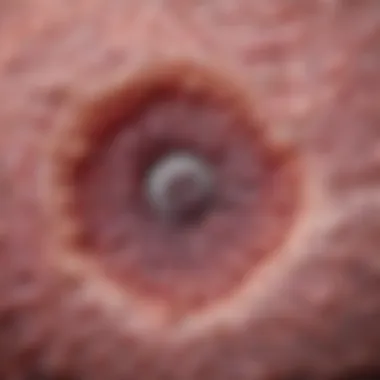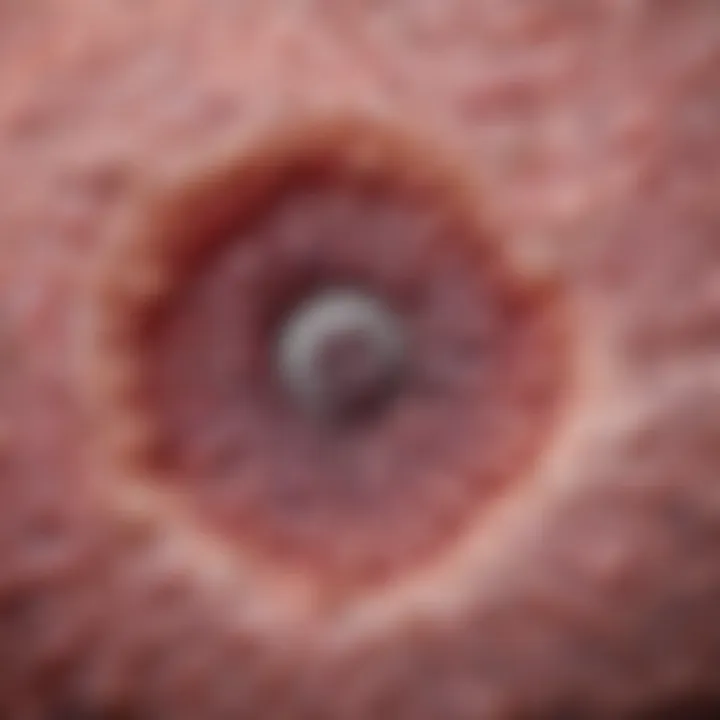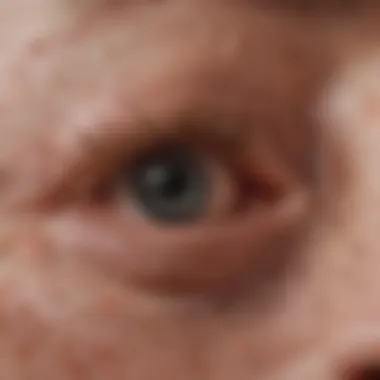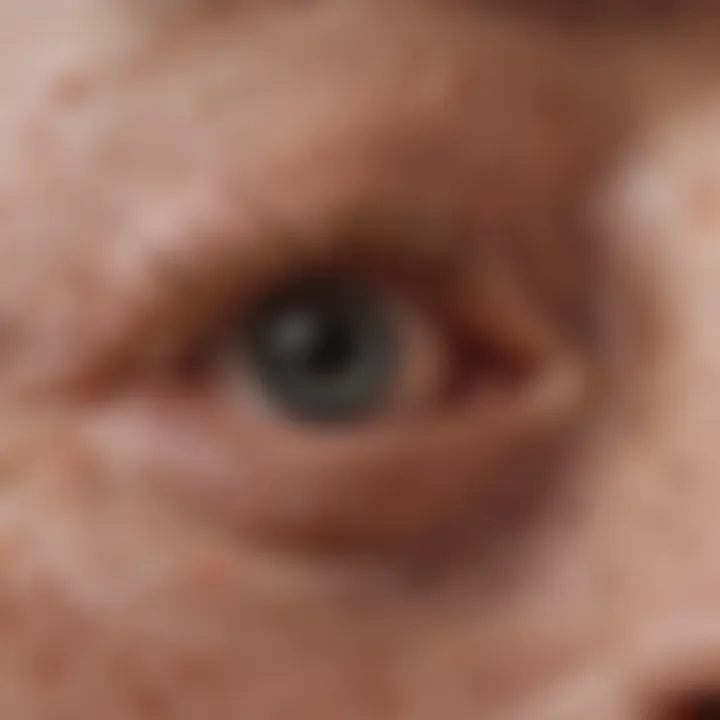Comprehensive Overview of Aggressive Basal Cell Carcinoma


Intro
Aggressive basal cell carcinoma (ABCC) represents a more invasive form of basal cell carcinoma (BCC) than its more common counterparts. As an increasing concern in dermatologic oncology, ABCC demands a closer look due to its propensity for metastasis and local destruction. Understanding the complexities surrounding ABCC is essential for improving diagnosis and treatment, ultimately enhancing patient outcomes. In this exploration, we will dissect the intricacies of ABCC, illuminating its distinct features and impacting patient care strategies in a clinical setting.
Background and Context
Overview of the research topic
ABCC is a less frequently recognized yet critical subset of basal cell carcinoma, which itself is the most prevalent form of skin cancer globally. Unlike typical BCC, which tends to grow slowly and usually remains localized, aggressive variants demonstrate a capacity for significant invasion and aggressive behavior. It’s vital to differentiate ABCC from the usual presentations to avoid mismanagement and ensure appropriate intervention.
Historical significance
Historically, the literature around basal cell carcinoma focused predominantly on its benign nature. This perception often led to underrecognition of aggressive forms. However, with advancements in dermatopathology and oncology, the clinical nuances of ABCC began capturing the attention of researchers. Landmark studies in the past two decades have gradually shifted perceptions, emphasizing the importance of an accurate diagnosis to inform therapeutic decision-making.
"Aggressive BCC should not be taken lightly. Given its potential for extensive local growth and rare metastasis, a nuanced understanding is essential to managing this malignancy effectively."
Key Findings and Discussion
Major results of the study
Several recent studies underline the critical factors that define aggressive basal cell carcinoma, including genetic mutations, histological subtypes, and the overall impact on treatment outcomes. Key mutations often found in these cancers include alterations in the PTC gene and others linked to the hedgehog signaling pathway. Recognizing these specific genetic markers can help inform risk stratification and therapeutic approaches.
Detailed analysis of findings
A thorough examination of clinical records has shown that patients with aggressive basal cell carcinoma often present with lesions that are larger, deeper, and infiltrative compared to traditional BCC. Key characteristics spotted include:
- Severe local tissue destruction
- Complex histological patterns, often overlapping with squamous cell carcinoma
- Higher risks of recurrence after treatment
Understanding these aspects creates pathways for better patient education, enabling practitioners to guide those affected by ABCC on signs to look out for, and the paramount importance of early detection.
Understanding Basal Cell Carcinoma
Basal cell carcinoma (BCC) is a common form of skin cancer that arises from the basal cells in the epidermis. Grasping the importance of understanding this malignant neoplasm is not just essential for clinicians, but also for patients, caregivers, and the general population. Knowledge regarding basal cell carcinoma can empower individuals to recognize potential signs early, facilitating timely diagnosis and intervention.
Definition and Classification
BCC can be categorized into several subtypes based on histological characteristics and patterns. The major subtypes include:
- Nodular Basal Cell Carcinoma: This is the most prevalent form, generally presenting as a pearly dome-shaped nodule with visible blood vessels.
- Superficial Basal Cell Carcinoma: Often mistaken for eczema or a benign mole, it appears as a flat, red spot, usually found on the torso.
- Morphoeic Basal Cell Carcinoma: This subtype is less common but more aggressive, appearing as a scar-like patch that can infiltrate deeply into the surrounding tissues.
- Pigmented Basal Cell Carcinoma: Characterized by dark pigment, this type is sometimes confused with melanoma.
Each classification not only helps in understanding the cancer’s behavior and prognosis but also guides treatment decisions.
Epidemiology
Understanding the epidemiology of basal cell carcinoma is critical. BCC accounts for a significant majority of skin cancer cases, making it crucial to grasp its prevalence and the risk factors associated with it. The incidence of basal cell carcinoma has been on a steady rise, especially in populations with lighter skin tones. The American Academy of Dermatology notes that nearly 3.6 million cases of BCC are diagnosed annually in the United States alone.
Certain demographic factors contribute to the risk of developing BCC:
- Age: Generally, individuals over 50 years old are at greater risk.
- Skin Type: Those with fair skin, light hair, and blue or green eyes are more likely to develop this type of cancer.
- Exposure to UV Radiation: Both natural sunlight and artificial sources, like tanning beds, have significant impact on the likelihood of developing BCC.
Considering these factors is essential, as it can influence programs for early detection and prevention strategies.
"Awareness and education can significantly reduce the burden of basal cell carcinoma by encouraging preventive behaviours and regular skin check-ups."
A thorough understanding of basal cell carcinoma serves as a foundation for delving into more aggressive forms of the disease. Knowledge enables both medical professionals and patients to navigate the complexities of this malignancy, ensuring informed decisions and improved health outcomes.
Defining Aggressive Basal Cell Carcinoma
Understanding aggressive basal cell carcinoma is crucial for several reasons. This form of skin cancer stands apart from its less invasive counterparts, making its differentiation essential for effective treatment and patient management.
When you think of basal cell carcinoma, the common image might be one of a slow-growing lesion that can often be left unattended for long periods. However, aggressive basal cell carcinoma breaks that mold. The recognition of its unique features can mean the difference between prompt interventions versus waiting too long. Delaying action isn’t just a matter of inconvenience; it can significantly affect the patient’s quality of life, and potentially their health outcomes.
Characteristics of Aggressive Forms
Aggressive basal cell carcinoma bears distinct characteristics that set it apart from more typical forms. These include:
- Rapid growth: Unlike the more common basal cell carcinomas, aggressive ones often display rapid progression, thus requiring swift intervention.
- Invasive behavior: These cancer types tend to infiltrate surrounding tissues more deeply, which can complicate treatment options.
- Higher recurrence rates: Patients may experience multiple instances of the cancer returning if not addressed in a timely and effective manner.
- Location matters: Areas like the face, head, or neck are more prone to aggressive forms, increasing the cosmetic and functional stakes involved in treatment.
Furthermore, tumor subtypes, such as morpheaform or micronodular, are known to exhibit aggressive behavior. Recognizing these forms allows for more tailored treatment strategies that can reduce the likelihood of recurrence and improve overall patient outcomes.
Differentiating from Non-Aggressive Types
Distinguishing aggressive basal cell carcinoma from its non-aggressive variants is a critical task for both clinicians and pathologists.
- Clinical appearance: While non-aggressive forms may present as pearly nodules, aggressive variants often appear more irregular or ulcerated, showing erratic edges or even bleeding.
- Histological analysis: Under the microscope, aggressive forms have a more chaotic architecture and can display perineural invasion, a feature not commonly seen in non-aggressive types.
- Growth patterns: The rate of growth alone is often a red flag—if a lesion changes in appearance or size dramatically within months, that could signify something more menacing is at play.


In summary, understanding these differences equips healthcare providers with the knowledge necessary to approach diagnosis and treatment with heightened vigilance.
"An early diagnosis is a lifeline. Recognizing aggressive basal cell carcinoma sooner can help preserve not only physical health but also the emotional well-being of patients."
In light of this information, it's evident why awareness and education in distinguishing aggressive basal cell carcinoma are paramount. Such knowledge not only empowers healthcare professionals but also patients, fostering a proactive approach to skin health.
Pathophysiology of Aggressive Basal Cell Carcinoma
Understanding the pathophysiology of aggressive basal cell carcinoma (BCC) is critical for both accurate diagnosis and effective treatment. This skin cancer subtype exhibits unusual behaviors that sets it apart from its more common forms. Knowing how it manifests at the molecular level can illuminate potential avenues for intervention and management. As awareness around aggressive BCC grows, so does the necessity to unpack the complexities surrounding its pathophysiology.
Molecular Mechanisms
The mechanisms underlying aggressive BCC are multi-faceted, blending genetic, environmental, and cellular factors. One prominent feature is the dysregulation of the sonic hedgehog signaling pathway, which plays a critical role in cell growth and differentiation. When this pathway goes awry, it can lead to unchecked cellular proliferation, contributing to the aggressive nature of the carcinoma.
Another vital player is the involvement of various growth factors and their receptors. For instance, the epidermal growth factor receptor (EGFR) is often overexpressed in aggressive forms of BCC. This overexpression can lead to enhanced signaling pathways that promote not just survival of the cancerous cells, but also their invasiveness into surrounding tissues.
"Molecular insights into aggressive basal cell carcinoma can pave the way for targeted therapies, transforming management approaches and potentially improving outcomes."
Genetic Mutations Involved
A variety of genetic mutations have been identified as accomplices in the formation and progression of aggressive BCC. At the forefront is the mutation in the PTC gene, often associated with the Gorlin syndrome, which predisposes individuals to multiple skin cancers, including aggressive BCC. The PTC gene typically encodes a protein that inhibits the sonic hedgehog pathway. When mutated, this inhibition is lifted, unleashing rapid cell division and tumor formation.
Additionally, other mutations such as those in the TP53 gene also play a significant role. The TP53 gene is known as the tumor suppressor gene, and mutations here often lead to failure in cell cycle regulation, contributing to the aggressive behavior of BCC.
An understanding of these genetic underpinnings is pivotal; it not only helps in tailoring treatment but also offers insights into potential genetic screening in high-risk populations of aggressive BCC.
The intricate interplay of these molecular mechanisms and genetic mutations offers a roadmap for future research, emphasizing the need for continued exploration into the pathophysiology of aggressive basal cell carcinoma.
Clinical Presentation
The clinical presentation of aggressive basal cell carcinoma (BCC) is pivotal for understanding this malignancy's impact on patients and guiding effective treatment strategies. Early recognition of symptoms and associated signs can significantly influence the clinical outcomes, making a clear grasp of this section crucial. In clinical practice, aggressive forms may often present differently than their non-aggressive counterparts, requiring heightened awareness from healthcare providers.
Symptoms and Signs
Aggressive basal cell carcinoma can manifest through a variety of symptoms and signs that might not be readily apparent at first glance. Here are some key indicators:
- Persistent Ulcers or Sores: A common sign includes wounds that do not heal or ulcers that bleed consistently. They can appear crusty and may ooze.
- Rapid Growth: Unlike other types of BCC, aggressive forms often exhibit rapid alterations in size, leading to significant concern over their behavior.
- Defined Borders: Lesions might demonstrate an irregular outline, suggesting a more invasive nature. Such lesions can take on a pink or flesh-colored appearance.
- Surrounding Tissue Changes: Healthy tissue can become inflamed or discolored near the site of the growth.
- Nerve Involvement: In advanced cases, symptoms might extend to neuropathic pain if the carcinoma invades nearby nerves, leading to signs such as tingling or numbness.
Recognizing these symptoms isn't merely academic; staying alert to these signs could help clinicians diagnose aggressive BCC more swiftly, which is crucial for improving patient outcomes.
Diagnostic Challenges
The diagnostic landscape for aggressive basal cell carcinoma is fraught with challenges that can complicate timely and accurate identification. A few of the hurdles faced by clinicians include:
- Similarities to Other Skin Lesions: Aggressive BCC can be easily mistaken for other skin conditions like psoriasis or eczema due to overlapping characteristics.
- Underestimating Severity: Physicians may initially regard suspicious lesions as benign given their appearance, leading to a delay in further evaluation.
- Site-Specific Issues: Lesion location can affect visibility and detection; for instance, those areas with thicker skin or hidden sites may go unnoticed longer.
- Patient Variability: Symptoms can differ dramatically from one patient to another based on various factors, including skin type and genetic susceptibility, making standard diagnostics difficult.
- Limitations of Imaging Techniques: While imaging can assist in assessing lesion depth and involvement, it might not provide enough clarity for definitive diagnosis, often requiring histopathological confirmation.
In light of these challenges, developing a systematic approach to diagnosis can benefit practitioners. Increased familiarity with aggressive presentations and proactive assessment strategies are vital in addressing these obstacles effectively.
"With aggressive basal cell carcinoma, early diagnosis is not just crucial; it can mean the difference between localized treatment and extensive surgical intervention."
Overall, understanding the intricate clinical presentations of aggressive basal cell carcinoma is not merely an academic exercise; it serves as a critical guide for healthcare professionals in the early stages of patient evaluation and treatment plans.
Diagnosis of Aggressive Basal Cell Carcinoma
The diagnosis of aggressive basal cell carcinoma (aBCC) holds paramount significance in managing this invasive form of skin cancer. Recognizing it in the early stages can make an eagle-eyed difference in treatment outcomes and overall patient wellbeing. The intricate dance between identifying the disease and implementing appropriate interventions can directly influence survival rates and quality of life for patients. Therefore, solid knowledge of diagnostic processes is crucial for healthcare professionals and can empower patients to seek timely medical attention.
Clinical Assessment
In the clinical setting, assessing aBCC largely revolves around thorough history-taking and careful physical examination of the skin. This process can be complex due to varying clinical presentations. For instance, unlike the more typical basal cell carcinomas that might resemble a small, pearly nodule, aggressive forms can manifest more insidiously. Patients may present with:
- Ulcerations that do not heal
- Rapidly enlarging lesions
- Lesions in atypical locations (like the scalp or behind the ears)
A meticulous evaluation can reveal insight into the behavior of the lesions. Moreover, clinicians might ask about previous skin cancers, sun exposure history, and any family history of skin conditions. This information is vital as it helps paint a broader picture of the patient’s skin health. The combination of these elements serves as the foundation for diagnosing aBCC reliably.
Biopsy Techniques
Once a clinical assessment suggests the possibility of aggressive basal cell carcinoma, the next step involves obtaining a tissue sample through biopsy. There are various biopsy techniques available. The most common include:
- Shave Biopsy: Involves shaving off the top of the lesion and is often used for superficial lesions.
- Punch Biopsy: Excises a cylindrical core of skin, allowing deeper tissue examination.
- Excisional Biopsy: Removes the entire lesion and a surrounding rim of normal tissue for comprehensive analysis.
Each technique has its merits. For example, a punch biopsy allows for deeper penetration into the skin layers, which can be critical in determining the characteristics of aBCC. Proper technique selection is crucial, as it can influence clarity in histopathological evaluation.
Histopathological Examination
A definitive diagnosis of aggressive basal cell carcinoma hinges on histopathological examination carried out by a qualified pathologist. This examination looks at the microscopic characteristics of the tissue sample taken during a biopsy. Specific features that pathologists look for include:


- Increased cellularity and atypical keratinocytes
- Invasion of the stroma with nests or cords of basaloid cells
- Perineural invasion, which is an ominous sign indicating aggressive behavior
The histopathological report will categorize the type of aBCC and may even identify specific subtypes such as infiltrative or morpheiform basal cell carcinoma. This information is indispensable. It not only confirms the presence of the cancer but also gives insights into its possible behavior, guiding the subsequent treatment plan.
A comprehensive diagnosis of aBCC incorporates clinical assessment, biopsy techniques, and histopathological examination, which together create a robust framework for effective patient management.
Treatment Options
Treatment options for aggressive basal cell carcinoma (BCC) are pivotal to managing this severe form of skin cancer. The choice of treatment hinges on various factors, including the tumor's size, location, depth, and the patient's overall health. Each approach can be tailored to the individual, emphasizing the importance of a comprehensive strategy that balances efficacy with patient quality of life.
Surgical Approaches
Surgical intervention is often the first line of defense against aggressive BCC. One primary method is Mohs micrographic surgery, which stands out due to its precision in excising cancerous cells while preserving healthy skin. This technique allows for immediate microscopic evaluation, significantly reducing the chance of recurrence.
- Advantages of Mohs Surgery:
- Maximal Tissue Preservation: While ensuring complete tumor removal, it maintains surrounding tissue integrity, important in areas with delicate skin.
- Real-Time Analysis: The immediate feedback from the pathology team allows for on-the-spot adjustments if cancerous cells remain.
Another surgical option is traditional excisional surgery, where the cancerous tissue is cut out with a margin of surrounding healthy tissue. This method requires careful planning to ensure adequate margins, particularly for more invasive cancers.
Non-Surgical Treatments
Non-surgical methods are valuable alternatives, particularly for patients who might not be candidates for surgery due to health concerns or tumor location. Non-Surgical treatments include:
- Topical Chemotherapy: Medications like 5-fluorouracil or imiquimod can be applied directly to the skin. These treatments are often used for superficial BCC, requiring consistent application over weeks.
- Photodynamic Therapy (PDT): This approach employs a photosensitizing agent activated by specific wavelengths of light, targeting cancer cells. This method is particularly beneficial for superficial BCC but may not penetrate sufficiently for deeper tumors.
These options can be more appealing to patients, as they often come with fewer side effects and a less daunting recovery process compared to surgery.
Emerging Therapeutics
As research in oncology evolves, new treatments for aggressive BCC are being developed. Targeted therapies and immunotherapy are gaining traction. For instance, medications that inhibit pathways crucial for tumor growth, such as Hedgehog pathway inhibitors, have shown promise in clinical settings.
"Innovations in treatment methods illustrate the shifting landscape of skin cancer therapy, offering hope where current options may fall short."
Additionally, immunotherapy aims to boost the body’s immune response against the cancer, utilizing agents that can help the immune system identify and combat the malignancy more efficiently. While these treatments show potential, ongoing research is needed to fully understand their effectiveness and long-term impacts.
Through each treatment modality, from surgical to non-surgical and emerging options, the overall goal remains the same: effectively manage aggressive basal cell carcinoma while striving to maintain the patient's quality of life.
Prognosis and Outcomes
Understanding the prognosis and outcomes of aggressive basal cell carcinoma (BCC) is crucial, as it directs treatment decisions, informs risk assessment, and shapes patient expectations. Prognostic factors offer insights into how well a patient might respond to treatment, while outcome statistics assist healthcare professionals in crafting tailored treatment strategies.
In aggressive forms of BCC, prognosis can be influenced by several factors, including tumor size, location, and histological subtype. Individual patient characteristics, such as age, overall health, and prior treatment history, also play significant roles. Knowing these elements can help physicians anticipate potential challenges and plan accordingly, providing better care.
Factors Influencing Prognosis
Several key factors can sway the prognosis of aggressive basal cell carcinoma. Some of the most pertinent include:
- Tumor Size: Larger tumors often correlate with more advanced disease, and this can make treatment more complicated. A small tumor might be addressed with a simple excision, whereas a sprawling mass may require more aggressive interventions.
- Invasion Depth: Depth of invasion into the skin layers significantly affects outcomes. Greater invasion usually means a tougher uphill battle for treatment efficacy.
- Location: Tumors arising in delicate areas, such as around the eyes or ears, may present unique challenges. These locations have higher risks of recurrence and complicated repair.
- Histological Subtypes: Certain aggressive subtypes, such as infiltrative and morpheaform BCC, have worse prognoses compared to nodular basal cell carcinoma. Knowing the subtype helps clinicians predict treatment responses.
- Patient Factors: Age, comorbidities, and overall immune function can impact healing and response to therapy. Older patients might find recovery slower due to underlying health conditions.
These elements create a complex picture for each patient. Each person’s case is unique, and the convergence of these factors determines their specific path. This leads us to a crucial idea:
“Prognostic assessments should be individualized, considering both tumor and patient aspects to better navigate the cancer journey.”
Survival Rates and Statistics
Survival rates provide a general overview of outcomes associated with aggressive basal cell carcinoma and serve as benchmarks against which to measure individual cases. While BCC generally has a good prognosis, aggressive variants pose challenges that can muddle these statistics.
- Five-Year Survival Rate: The five-year survival rate for all forms of basal cell carcinoma is approximately 90-95%, but aggressive types can lower this figure due to their invasiveness.
- Recurrence Rates: Aggressive BCCs have recurrent rates ranging from 20% to 30%, especially when treatment involves less than complete excision.
- Regional Differences: Outcomes may vary based on geographic location, access to care, and healthcare systems. For example, patients in urban areas with specialized dermatology centers might achieve better outcomes than those in remote regions lacking resources.
Furthermore, ongoing research continues to refine these statistics. New therapeutic approaches and a deeper understanding of genetic factors may lead to improved outcomes over time. Keeping abreast of current studies is essential for practitioners to apply the latest insights in clinical practice.
Patient Care Considerations
The significance of patient care considerations in the context of aggressive basal cell carcinoma cannot be overstated. It serves as the foundation for achieving better health outcomes while navigating the often complex landscape of skin cancer treatment. This section delves into key aspects, including the management of treatment side effects and the psychosocial impact on patients. Understanding these elements is essential for both practitioners and patients, as they foster a comprehensive approach to care.
Managing Treatment Side Effects
Managing the side effects of treatment is a critical aspect of patient care. Patients undergoing therapies for aggressive basal cell carcinoma often experience a range of physical and emotional symptoms. These can include fatigue, pain, skin irritation, and psychological distress. Treatment plans must therefore be individualized, taking into account each patient's unique circumstances.
- Communication: Open dialogue between healthcare providers and patients about potential side effects can make a world of difference. When patients are aware of what to expect, they often feel more empowered and less anxious.
- Symptom Management: Effective strategies for managing side effects include:
- Pain relief through medications such as acetaminophen or stronger opioids if needed.
- Topical treatments for skin irritation; moisturizing creams can soothe discomfort.
- Psychological support, like counseling or support groups, which can address anxiety related to treatment.
"Understanding the potential side effects of treatment fosters resilience in patients and equips them to better cope with their journey."


- Follow-Ups: Regular follow-up appointments help in the early identification and management of any complications related to the treatment. Adjustments to therapy can also be made based on the patient's response.
Psychosocial Impact
The psychosocial implications of aggressive basal cell carcinoma are profound and warrant careful consideration. Cancer isn't just a physical illness; its effects weave through emotional, social, and psychological spheres.
- Emotional Distress: Many patients experience anxiety, depression, or a sense of loss, which can stem from physical changes, treatment side effects, or the fear of disease progression. Addressing these emotional challenges is just as crucial as treating the cancer itself.
- Social Dynamics: Patients may also face changes in their relationships with family, friends, and colleagues. There can be a sense of isolation or withdrawal from social activities, sometimes fueled by self-consciousness about visible skin lesions or the fatigue experienced during treatment.
- Support Systems: Encouraging the development of support networks is vital. Patients should be motivated to reach out to family, friends, or local support groups. Resources like the American Cancer Society can provide not only practical assistance but also emotional support through shared experiences.
- Mental Health Services: Access to mental health professionals can offer tailored strategies for coping with the psychosocial impacts of aggressive basal cell carcinoma. Services such as psychotherapy or behavioral therapy can lead to better quality of life during and after treatment.
In summary, patient care considerations are pivotal in managing aggressive basal cell carcinoma. A well-rounded approach ensures that patients are not only combating the physical aspects of the disease but also actively addressing the emotional and social factors that influence their overall well-being.
Prevention Strategies
Preventing aggressive basal cell carcinoma (BCC) is paramount, considering the invasive nature of this skin cancer type. The implementation of effective strategies can significantly reduce the risk of developing this malignancy. Adopting preventive measures is not just about avoiding potential skin damage; it’s about fostering a holistic approach to skin health. Patients, practitioners, and educators need to work collaboratively to promote awareness and understanding of these strategies.
The benefits of prevention strategies extend beyond mere avoidance of cancer. They also encompass broader health implications, such as improved quality of life, reduced treatment costs, and heightened awareness around skin health. Let’s delve into specific prevention methods that can help mitigate the risks associated with aggressive basal cell carcinoma.
Sun Protection Guidelines
When it comes to preventing skin cancer, sun protection is at the forefront. The sun emits ultraviolet (UV) radiation that can cause significant DNA damage in skin cells, potentially leading to aggressive BCC. Here are some key guidelines to adhere to:
- Sunscreen Use: Apply a broad-spectrum sunscreen with at least SPF 30. This should be done generously 15-30 minutes before going outdoors, and reapplication every two hours is essential, especially after swimming or sweating.
- Protective Clothing: Wearing long-sleeved shirts, wide-brimmed hats, and UV-blocking sunglasses can provide physical barriers against sun exposure. Fabrics with tight weaves and darker colors often offer better protection.
- Seek Shade: During peak sun hours, typically between 10 a.m. and 4 p.m., finding shade can dramatically reduce UV exposure. Consider using umbrellas or canopies when outside.
- Avoid Tanning Beds: The artificial UV rays from tanning beds can cause similar damage as sunlight. Steering clear of these devices helps minimize the risk of skin damage.
"An ounce of prevention is worth a pound of cure." This adage encapsulates the essence of sun protection.
Regular Skin Check-Ups
Regular skin check-ups play a crucial role in early detection and prevention of aggressive basal cell carcinoma. By becoming familiar with their own skin, individuals can detect any unusual changes that might warrant further evaluation. Here are important aspects of regular skin examinations:
- Self-Examination: Patients should inspect their skin monthly, looking for new moles or changes in existing ones. The ABCDE rule can help in assessing moles:
- Professional Assessments: Schedule annual visits with a dermatologist, especially for high-risk individuals. Professionals have the expertise to identify potential malignancies often overlooked during self-exams.
- Educational Resources: Utilize available educational materials and resources from reputable organizations. Websites like Wikipedia and Britannica offer valuable insights into skin health and the importance of regular check-ups.
- Peer Support: Encouraging friends and family to join in skin check practices can enhance awareness and promote a supportive environment for skin health.
- Asymmetry
- Border irregularity
- Color variation
- Diameter larger than 6 mm
- Evolving in size, shape, or color
Implementing these prevention strategies can lead to favorable outcomes in the fight against aggressive basal cell carcinoma. By prioritizing sun protection and regular skin assessments, individuals can take charge of their dermatological health and significantly reduce their risk of this invasive cancer.
Future Directions in Research
Research in the field of aggressive basal cell carcinoma is not just needed; it's vital. As this form of skin cancer continues to pose challenges for healthcare professionals and patients alike, the exploration of innovative diagnostic techniques and potential advances in therapy is necessary. Understanding these future directions can lead to better clinical outcomes, earlier detection, and more personalized treatment options. The impact of new research reaches far beyond just the existing medical community; it paves the way for a future where patients can have tailored care that suits their specific needs.
Innovative Diagnostic Techniques
The early and accurate diagnosis of aggressive basal cell carcinoma is crucial to improving patient outcomes. Traditional methods, while effective, can sometimes fall short, particularly when it comes to identifying the most invasive forms of the disease. New diagnostic techniques are emerging that promise to enhance our understanding and treatment of this carcinoma.
- Molecular Diagnostics
Utilizing advanced technology, molecular diagnostics can assist in identifying unique genetic markers associated with aggressive forms of basal cell carcinoma. For instance, sequencing technologies like next-generation sequencing are showing promise in revealing mutations that could herald more aggressive behavior. - Imaging Techniques
Enhanced imaging methods such as high-frequency ultrasound or even MRI can aid in visualizing the extent of tumor invasion into surrounding tissues. These tools can provide a clearer picture of the disease's progression, thus informing treatment decisions
"As we push the boundaries of diagnostic technology, we aim to not just treat the disease but to foresee its trajectory, allowing for preemptive action rather than reactive treatment."
- Artificial Intelligence
The integration of artificial intelligence (AI) in diagnostic practices is revolutionizing how we approach skin conditions. AI algorithms can analyze images from biopsies or scans and identify patterns that a human eye might overlook. As this technology advances, it holds the potential to serve as a second pair of eyes in the diagnostic process.
Potential Advances in Therapy
When it comes to treating aggressive basal cell carcinoma, researchers are exploring numerous innovative therapeutic approaches that aim to tackle the limitations of current methods. Below are some noteworthy directions:
- Targeted Therapy
Rather than applying a one-size-fits-all method, targeted therapies focus on specific molecular pathways involved in tumor growth. Researchers are investigating drugs that inhibit the Hedgehog signaling pathway, a critical driver in many basal cell carcinomas. By disrupting these signals, the hope is that we can halt the progression of aggressive tumors significantly. - Immunotherapy
Harnessing the body’s immune system to fight cancer is an area gaining traction. Various immunotherapeutic agents developed for treating other cancer types are being studied for their effectiveness against basal cell carcinoma. This approach can potentially yield fewer side effects than traditional therapies, combined with more robust responses. - Combination Therapies
Research is indicating that a combined approach may enhance treatment efficacy. By pairing chemotherapeutic agents with immune modulators, there's a potential to exploit multiple angles in fighting the cancer, leading to improved patient outcomes.
As we look ahead, it’s clear that the future of rigorous research in aggressive basal cell carcinoma holds substantial promise. From diagnostics that can flag aggressive forms early on to therapies that address the cancer at its molecular roots, the pathways to better management are becoming clearer. With ongoing commitment and innovation, tackling this challenging skin cancer could transform patient outcomes for the better.
Closure
Understanding aggressive basal cell carcinoma (BCC) is not just a medical necessity but also a crucial aspect of public health education. As we've explored throughout this article, aggressive BCC presents unique characteristics that distinguish it from more common forms of the disease. This distinction bears significant implications for diagnosis, treatment approaches, and overall patient management.
Key insights from the previous sections illuminate the need for a proactive stance when dealing with skin cancer. Educating patients and healthcare providers about the aggressive nature of some BCC variants can effectively reduce misdiagnosis and ensure timely treatment. It is vital that both practitioners and patients are equipped with the knowledge necessary to identify symptoms early and understand their treatment options.
Moreover, taking a closer look at this malignancy can aid in demystifying the complexities surrounding skin cancers. For instance, raising awareness about genetic mutations and the pathophysiological mechanisms can empower individuals, enhancing their participation in their own healthcare decisions.
A comprehensive understanding of aggressive BCC not only ensures that those affected receive the appropriate and timely care they need, it also contributes to the broader goal of reducing the incidence and prevalence of skin cancers globally.
Summary of Key Insights
- Aggressive Characteristics: Unlike non-aggressive forms, aggressive BCC can invade deeper into the skin and surrounding tissues, making early detection critical.
- Diagnostic Precision: Differentiating aggressive BCC from its less severe counterparts through molecular testing and thorough patient assessments is essential for effective treatment plans.
- Treatment Approaches: Options range from surgical interventions to innovative therapeutic methods, with patient outcomes significantly influenced by the nature and timing of treatment.
It is clear that a collaborative approach involving ongoing research, education, and enhanced clinical practices is necessary to improve outcomes for patients diagnosed with aggressive basal cell carcinoma.
The Importance of Awareness
The significance of awareness surrounding aggressive BCC cannot be understated. Knowledge serves as the first line of defense in combatting skin cancer. Public education campaigns focusing on risk factors, self-examination techniques, and the importance of timely consultations with dermatologists can save lives.
Considerations include:
- Early Detection: Recognizing early warning signs can lead to simpler and less invasive treatments.
- Community Engagement: Healthcare institutions can foster community awareness programs designed to educate on sun safety and skin health.
- Personal Responsibility: Individuals should be encouraged to practice sun protection and regular skin check-ups, recognizing that awareness is their armor in preventing skin cancers.
Engaging in conversations about the risks and realities of aggressive basal cell carcinoma will enhance general knowledge and facilitate a culture of vigilance.
"Awareness is key; knowledge can literally change lives. The more people know about aggressive basal cell carcinoma, the better equipped they will be to deal with it effectively."







